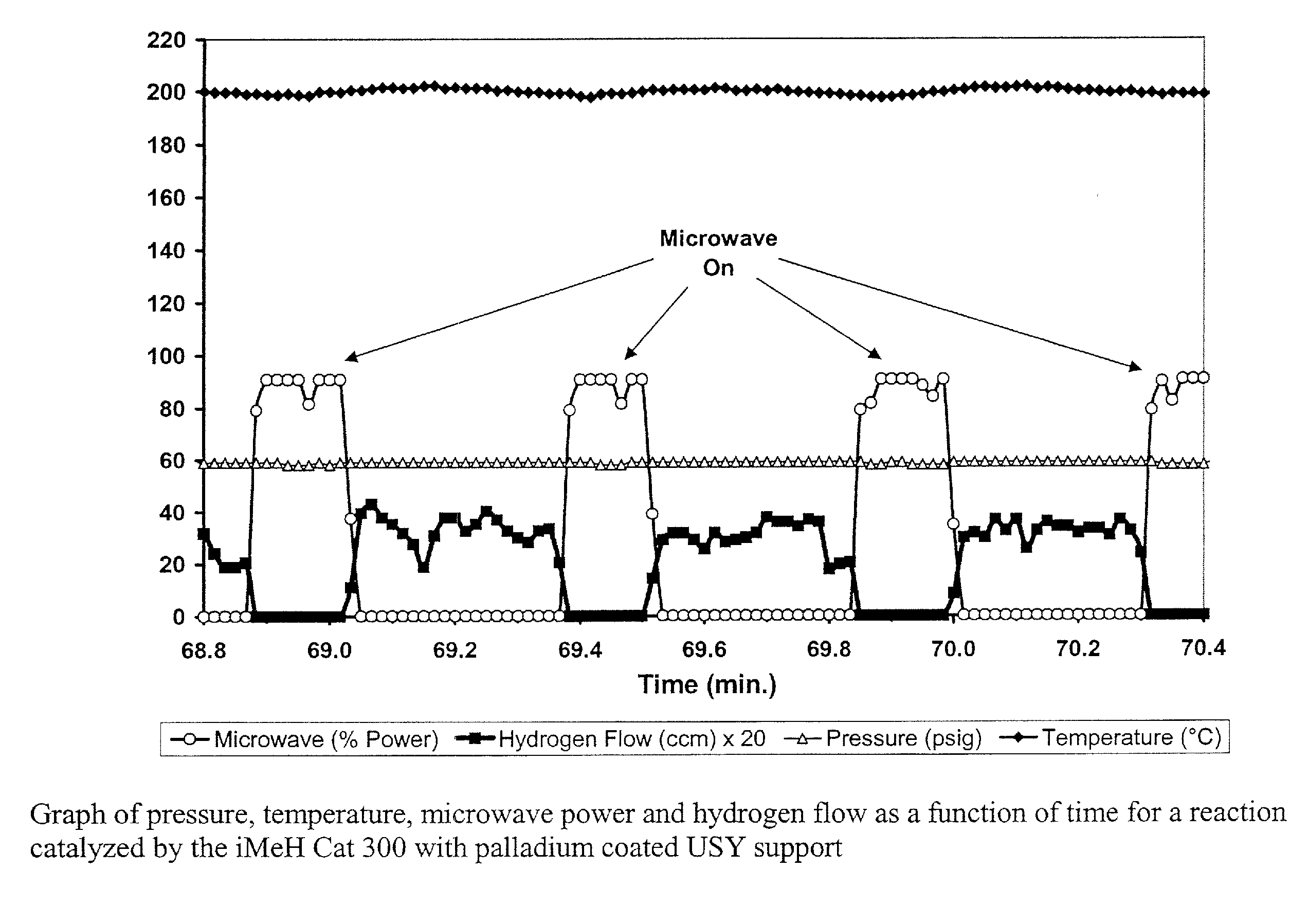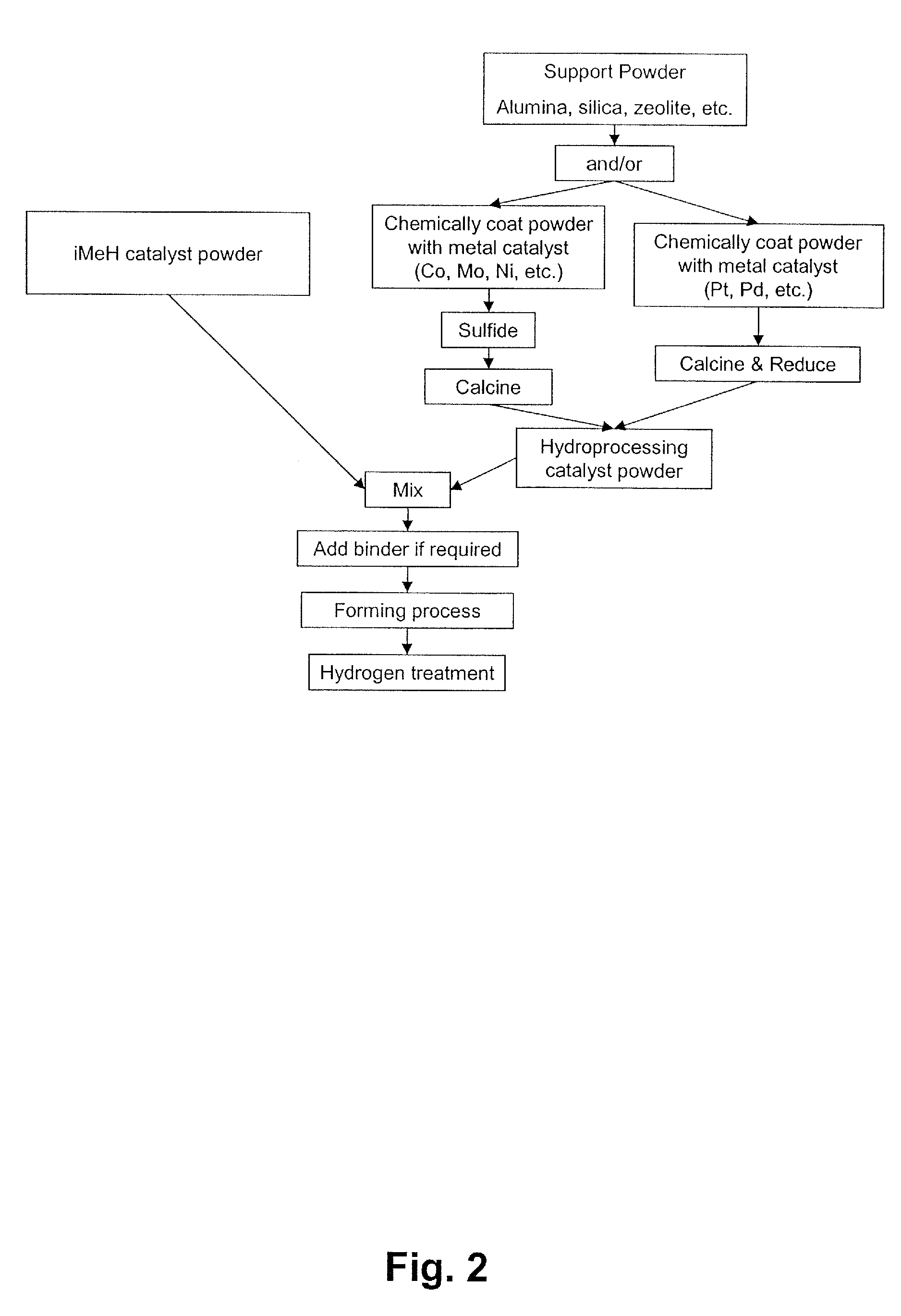Catalyst for the Treatment of Organic Compounds
a catalyst and organic compound technology, applied in the direction of catalyst activation/preparation, metal/metal-oxide/metal-hydroxide catalyst, final product manufacturing, etc., can solve the problems of catalysts using these metals being rendered inactive, conventional hydrocrackers are very costly to build and operate, and process requirements tend to be high pressure and temperatur
- Summary
- Abstract
- Description
- Claims
- Application Information
AI Technical Summary
Problems solved by technology
Method used
Image
Examples
example 1
Logarithmic Pressure Composition Isotherms of an iMeH Catalyst
[0119]FIG. 10 shows the logarithmic pressure composition isotherms for the monatomic hydrogen desorption curve of iMeH Cat 100, Mm(1.1)Ni(4.22)Co(0.42)Al(0.15)Mn(0.15). The plot displays the results at constant temperatures and equilibrium conditions for Cat 100 powder, relating pressure and stored iMeH hydrogen density. The plot shows that at a constant temperature, the iMeH hydrogen density increases as a non-linear function of pressure. The plot also shows that decreasing the temperature of the isotherms results in an increase of the iMeH hydrogen density. This data characterizes the iMeH catalyst's hydrogen capacity to provide monatomic hydrogen for hydrogenation or hydroprocessing reactions.
example 2
Selection of an iMeH Catalyst
[0120] To select an iMeH for a catalytic process, and to determine the operating parameters, it is useful to know how much hydrogen an iMeH material stores, the temperature at which the monatomic hydrogen desorbs, and the effect of pressure on monatomic hydrogen desorption.
[0121] In FIG. 11, plots of total hydrogen capacity versus temperature at ambient pressure are shown for Cat 100, Cat 200 and Cat 300, three example catalysts of the present invention. The compositions of these examples of iMeH catalysts according to the present invention are as follows:
Cat 100
Mm(1.1)Ni(4.22)Co(0.42)Al(0.5)Mn(0.5)
Cat 200
Nd(2.05)Dy(0.25)Fe(1.3)B(1.05)
Cat 300
Mg(0.05)Ni(0.95)Cu(0.07)
[0122] Given the standard industrial tolerances in the production of metals it is expected that very similar properties will be exhibited by a composition with the following general formulas:
Cat 100
Mm(30-34.5)(Ni, Co, Al, Mn)(69.9-66.4)
Cat 200
(Nd, Dy)(15.5-6.5)(Fe, B)(83.5-8...
example 3
Microwave Enhanced Hydroprocessing with Respect to Feedstock
[0125] For heavy oils, such as pitch residuum, microwave energy is preferentially absorbed by the aromatic and polar compounds in the oil thereby promoting their reaction. This is shown in FIG. 12 where the loss tangent (y-axis) for pitch residuum is approximately an order of magnitude greater than for microwave processed pitch (reduced molecular weight and lower boiling point) across a wide range of microwave frequencies (0.5-2.8 GHz). The loss tangent, also called loss factor or the dissipation factor, is a measure of the material's microwave adsorption. The loss tangent is also the ratio of the energy lost to the energy stored.
[0126] In hydroprocessing according to the present invention, the proper control and use of the dielectric loss tangent leads to the efficient use of microwave energy. The fraction of microwave energy, which is absorbed by any component of the oil and catalyst mixture, can be efficiently control...
PUM
| Property | Measurement | Unit |
|---|---|---|
| temperature | aaaaa | aaaaa |
| pressure | aaaaa | aaaaa |
| temperatures | aaaaa | aaaaa |
Abstract
Description
Claims
Application Information
 Login to View More
Login to View More - R&D
- Intellectual Property
- Life Sciences
- Materials
- Tech Scout
- Unparalleled Data Quality
- Higher Quality Content
- 60% Fewer Hallucinations
Browse by: Latest US Patents, China's latest patents, Technical Efficacy Thesaurus, Application Domain, Technology Topic, Popular Technical Reports.
© 2025 PatSnap. All rights reserved.Legal|Privacy policy|Modern Slavery Act Transparency Statement|Sitemap|About US| Contact US: help@patsnap.com



